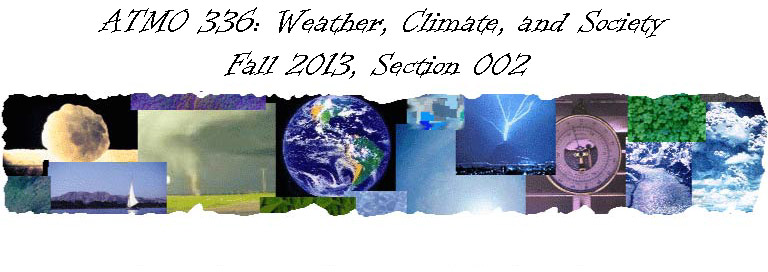
Reading pages for ATMO 336, section 002, Fall 2013. The course material is broken into four Modules listed below. Each page is accessible through its own link below. In addition "Next" and "Previous" buttons at the top and bottom of each reading page allow easy navigation through the material. For any other information regarding this class please go to the class homepage on D2L.
Module 1
Introduction to 500 mb mapsWinds at the 500 mb Height Level, Relationship to Southwest Monsoon, and Need for Water
Winds
Hurricane Introduction and Characteristics
Hurricane Movement and Damages
Hurricane Cycles, Links to Climate Change, and trends in hurricane damages in the USA
The atmosphere
Some properties of gases
Composition of the atmosphere
Temperature, pressure, and density of the atmosphere
Human response to air pressure and density changes
The Skew-T Diagram
Module 2
Water in the atmosphereA closer look at evaporation and condensation
Relative humidity and Dew Point
Energy Transfer
Temperature, humidity, wind, and human comfort
Clouds
Why Does Rising Air Cool?
Conditions under which air is forced to rise
Precipitation
Moving air parcels up and down through the atmosphere
Stability of the atmosphere
Introduction to Thunderstorms
Module 3
Thunderstorm Lifecycle and Severe ThunderstormsTornadoes
Lightning
Hurricane Energetics
Impacts of Extreme Weather; Possible Trends in Severe Weather
Ozone and the ozone hole
Ultraviolet radiation and its effects
Review 500 mb height maps
Review 500 mb winds; Estimating Precipitation areas from 500 mb maps
Weather forecasting using 500 mb height maps
The 500 mb weather pattern and weather terminology
A crash course in cyclogenesis
Numerical Weather Forecasting
Weather vs Climate
Introduction to Climate Change
Module 4
Solar Radiation and the Earth's Energy Budget IInfrared Radiation, Greenhouse Effect, and Earth's Energy Budget II
Increasing Greenhouse Gases
Atmospheric Carbon Dioxide and the Carbon Cycle
Uncertainty in Climate Prediction and Climate Models
Climate Models and their Predictions of Temperature Changes
Potential Impacts of Global Warming
Reconstructing Past Climates
The Climate of the Pleistocene
Is the Earth Fragile or Robust?
The Climate of the Holocene
Controversy: Global Average Temperature Reconstruction over the last 2000 years
The Present Warming: 20th Centrury through today
Global Warming Summary and Discussion
Seasonal Changes on Earth
Other Factors that Control Climate
Blue skies, red sunsets, white clouds, haze
End of reading material!